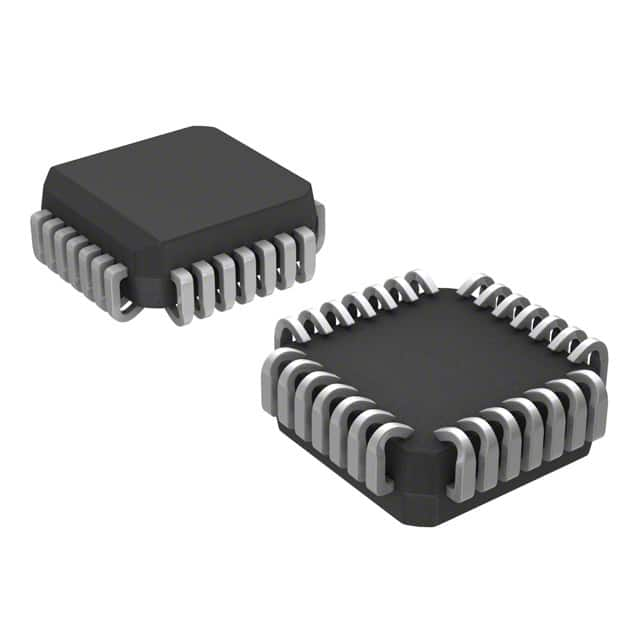Viz Specifikace pro podrobnosti o produktu.

MC10E171FN
Product Overview
- Category: Integrated Circuit (IC)
- Use: Logic Gate
- Characteristics: High-speed, ECL (Emitter-Coupled Logic) technology
- Package: 28-pin PLCC (Plastic Leaded Chip Carrier)
- Essence: High-performance logic gate for digital signal processing
- Packaging/Quantity: Available in reels of 250 units
Specifications
- Supply Voltage: -5.2V to -4.5V
- Operating Temperature Range: -40°C to +85°C
- Input Voltage Range: -2.0V to -0.8V
- Output Voltage Range: -2.0V to -0.8V
- Propagation Delay: 1.5 ns (typical)
- Maximum Clock Frequency: 500 MHz
Detailed Pin Configuration
The MC10E171FN has a total of 28 pins, which are assigned specific functions as follows:
- VEE – Negative power supply
- Q0 – Output of the first flip-flop
- Q1 – Output of the second flip-flop
- Q2 – Output of the third flip-flop
- Q3 – Output of the fourth flip-flop
- Q4 – Output of the fifth flip-flop
- Q5 – Output of the sixth flip-flop
- Q6 – Output of the seventh flip-flop
- Q7 – Output of the eighth flip-flop
- GND – Ground
- D0 – Data input for the first flip-flop
- D1 – Data input for the second flip-flop
- D2 – Data input for the third flip-flop
- D3 – Data input for the fourth flip-flop
- D4 – Data input for the fifth flip-flop
- D5 – Data input for the sixth flip-flop
- D6 – Data input for the seventh flip-flop
- D7 – Data input for the eighth flip-flop
- CLK – Clock input
- VCC – Positive power supply
- QN0 – Complementary output of the first flip-flop
- QN1 – Complementary output of the second flip-flop
- QN2 – Complementary output of the third flip-flop
- QN3 – Complementary output of the fourth flip-flop
- QN4 – Complementary output of the fifth flip-flop
- QN5 – Complementary output of the sixth flip-flop
- QN6 – Complementary output of the seventh flip-flop
- QN7 – Complementary output of the eighth flip-flop
Functional Features
- High-speed operation: The MC10E171FN is designed to operate at high clock frequencies, making it suitable for applications requiring fast signal processing.
- ECL technology: The use of Emitter-Coupled Logic ensures low propagation delay and high noise immunity, resulting in reliable and accurate logic operations.
- Multiple flip-flops: The IC incorporates eight flip-flops, allowing for the storage and manipulation of multiple bits of data simultaneously.
- Complementary outputs: In addition to the regular outputs, complementary outputs are provided, enabling differential signaling and facilitating noise rejection.
Advantages and Disadvantages
Advantages: - High-speed operation enables efficient digital signal processing. - ECL technology provides excellent noise immunity. - Multiple flip-flops allow for parallel data processing. - Complementary outputs enhance noise rejection.
Disadvantages: - Requires a negative power supply, which may add complexity to the system design. - Limited availability of alternative models from other manufacturers.
Working Principles
The MC10E171FN operates based on Emitter-Coupled Logic, where the logic gates are implemented using bipolar transistors. The inputs and outputs of the IC are differential, allowing for high-speed operation and noise rejection. The flip-flops within the IC store and manipulate data based on the clock input, enabling synchronous digital signal processing.
Detailed Application Field Plans
The MC10E171FN finds applications in various fields that require high-speed digital signal processing, such as: - Telecommunications: Used in high-speed data transmission systems, optical networks, and wireless communication equipment. - Data Centers: Employed in high-performance computing systems, network switches, and routers. - Test and Measurement: Utilized in high-speed test equipment, oscilloscopes, and logic analyzers. - Aerospace and Defense: Integrated into radar systems, avionics, and military communication devices.
Alternative Models
While the MC10E171FN is a highly capable logic gate, alternative models from other manufacturers can provide similar functionality. Some notable alternatives include: - SN74FCT16244T: Manufactured by Texas Instruments
Seznam 10 běžných otázek a odpovědí souvisejících s aplikací MC10E171FN v technických řešeních
Sure! Here are 10 common questions and answers related to the application of MC10E171FN in technical solutions:
Q: What is MC10E171FN? A: MC10E171FN is a high-speed ECL (Emitter-Coupled Logic) differential receiver designed for use in digital data transmission systems.
Q: What is the operating voltage range of MC10E171FN? A: The operating voltage range of MC10E171FN is typically between -4.2V and -5.7V.
Q: What is the maximum data rate supported by MC10E171FN? A: MC10E171FN can support data rates up to 1.5 Gbps (gigabits per second).
Q: Can MC10E171FN be used in both single-ended and differential applications? A: No, MC10E171FN is specifically designed for differential applications and cannot be used in single-ended configurations.
Q: What is the input sensitivity of MC10E171FN? A: The input sensitivity of MC10E171FN is typically 100 mV (millivolts) differential.
Q: Does MC10E171FN have built-in termination resistors? A: No, MC10E171FN does not have built-in termination resistors. External termination resistors are required for proper operation.
Q: Can MC10E171FN be used in low-power applications? A: No, MC10E171FN is not optimized for low-power applications. It is primarily intended for high-speed and high-performance designs.
Q: What is the output swing of MC10E171FN? A: The output swing of MC10E171FN is typically 800 mV (millivolts) differential.
Q: Is MC10E171FN compatible with other ECL logic families? A: Yes, MC10E171FN is compatible with other ECL logic families such as the 10K and 100K series.
Q: What are some typical applications of MC10E171FN? A: MC10E171FN is commonly used in high-speed data communication systems, clock distribution networks, and digital signal processing applications.
Please note that these answers are general and may vary depending on specific design requirements and datasheet specifications.

